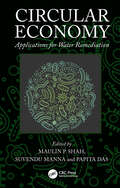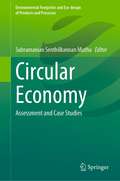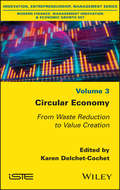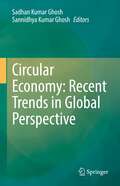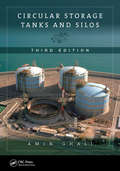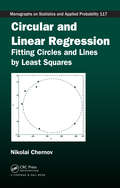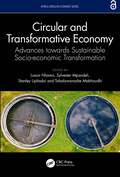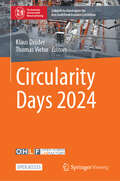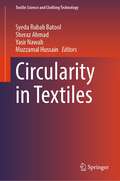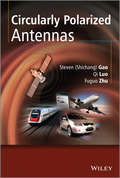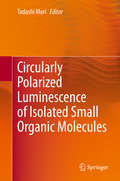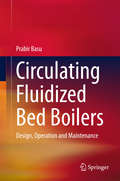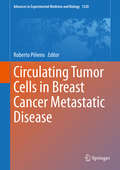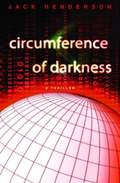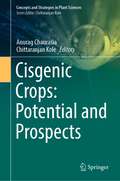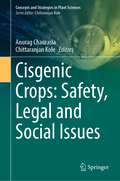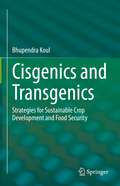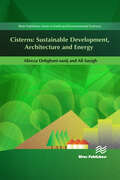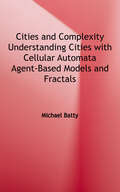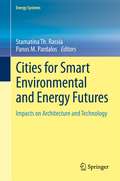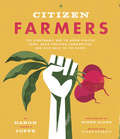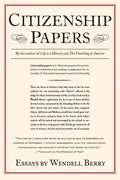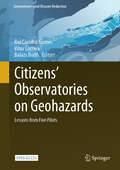- Table View
- List View
Circular Economy: Applications for Water Remediation
by Maulin P. Shah, Suvendu Manna, and Papita DasThe reclamation of wastewater (and other essential materials) is among the major research areas for understanding the effects of implementing a circular economic model. The re-use and re-cycling of wastewater can greatly reduce the overall demand for freshwater for various industrial applications. Such concepts could potentially greatly reduce the overall water demands of our planet if implemented successfully. Circular Economy: Applications for Water Remediation will examine the current understanding of the circular economy in water remediation processes, its drawbacks, and relatively unexplored areas that require further research. This book:• Provides an overview of the processes available to extract value-added materials from wastewater, such as clean water, nutrients, and energy.• Explores the possibilities of re-using wastewater for agricultural uses.• Provides an overview of the current policies and regulations concerning the implementation of circular economy concepts in wastewater remediation.
Circular Economy: Assessment and Case Studies (Environmental Footprints and Eco-design of Products and Processes)
by Subramanian Senthilkannan MuthuThis book highlights the notion of Circular Economy under the umbrella of Sustainability because of the widespread momentum it is gaining. Today the whole world is certainly in emergent need of an alternative system to traditional economy which is linear, i.e. make, use and dispose to get rid-off the waste and very important to ensure continuous use of resources, which is possible by the advent of circular economy. A circular economy aims to utilize the resources in use for as long as possible, extract the maximum value from them during use, then recover and regenerate products and materials at the end of each service life vis-à-vis traditional linear model. This book discusses circular economy in terms of assessment with various case studies.
Circular Economy: From Waste Reduction to Value Creation
by Karen Delchet-CochetThis book is aimed at companies, researchers, consultants, consumers, students and any interested public interested in the subject, the reflections and practices of the circular economy. As part of the draft law on the circular economy in France, the authors (researchers and experts) analyze the data and the reflections and base their arguments on real examples in order to propose solutions and recommendations for a green economy. It gives an updated overview of the reflections and practices around the circular economy. The book is divided into three parts: - The company and its functions, innovative business models - The institutional, legislative and normative framework - Some sectors of activity with the prism of the circular economy
Circular Economy: Recent Trends in Global Perspective
by Sadhan Kumar Ghosh Sannidhya Kumar GhoshThis book presents the advantages of the circular economy as a powerful - and inevitable - model for tackling the current challenges against shrinking resources and establishing the resource efficient economy. The experienced contributors present the status and strategies of circular economy implementation in several countries with hands on experience to protect the environment while promoting the circular economy through legislative requirements, best practices adopted and popularizing the idea of circulation of resources amongst the researchers & academia, policy makers, industry, and the general public at large. The book advocates model that consists of designing products and processes with a view to endlessly recycling them evolving a greater scope of sustainable development.
Circular Storage Tanks and Silos
by Amin GhaliThis book presents practical methods for the analysis and design of circular concrete tanks. The methods can also be used for silos, pipes, or any circular shells subjected to arbitrary axially symmetrical loading, and also deal with the more general problem of beam on elastic foundation. The book includes a new chapter on the design of construction of circular tanks, comes with new easy-to-use computer programs, and provides design examples that include post-tensioned concrete walls, footings, floors and roofs, and liquid-tight connections between these components.
Circular and Linear Regression: Fitting Circles and Lines by Least Squares (Chapman & Hall/CRC Monographs on Statistics and Applied Probability)
by Nikolai ChernovFind the right algorithm for your image processing applicationExploring the recent achievements that have occurred since the mid-1990s, Circular and Linear Regression: Fitting Circles and Lines by Least Squares explains how to use modern algorithms to fit geometric contours (circles and circular arcs) to observed data in image processing and comput
Circular and Transformative Economy: Advances towards Sustainable Socio-economic Transformation (Africa Circular Economy Series)
by Sylvester Mpandeli Stanley Liphadzi Tafadzwanashe Mabhaudhi Nhamo LuxonThe main aim of this book is to illustrate circular models for sustainable resource management. It highlights the benefits of transformative approaches in integrating, simplifying, and facilitating understanding of complex systems and transforming systems towards greater sustainability while achieving multiple social, economic, and environmental outcomes. It provides pathways towards strategic policy decisions on socio-economic transformation supported by case studies.Features: Discusses exploration of a transitional path to the circular economy, explored from the point of view of waste and technology. Explains transformational change towards sustainable socio-ecological interactions. Reviews provision of pathways towards sustainability through scenario development. Provides assessment of progress towards Sustainable Development Goals. Presents cross-sectoral and multicentric approaches towards circularity. This book is aimed at researchers and professionals in water and environmental engineering, circular economy, sustainability, and environmental studies.
Circularity Days 2024 (Zukunftstechnologien für den multifunktionalen Leichtbau)
by Thomas Vietor Klaus DröderThis book comprises the proceedings of the conference “Circularity Days 2024”, which took place from May 15th-16th in Wolfsburg. The conference focused on key topics such as Design for Remanufacturing, Circular Production, and Sustainable Materials and Applications. The emphasis was placed on products that are easily disassembled, repaired, and remanufactured, utilizing innovative manufacturing methods to minimize resource consumption, energy usage, and emissions, and highlighting eco-friendly materials and their role in achieving circularity. Especially circular production methods, which combine the advantages of minimal resource consumption and maximal reusability, have a high potential for reducing the environmental impact, while simultaneously extending the product lifecycle. The future, efficient and scalable integration of sustainable materials and circular production methods requires innovations and constant developments in design and manufacturing technology. This is an open access book.
Circularity in Textiles (Textile Science and Clothing Technology)
by Yasir Nawab Sheraz Ahmad Syeda Rubab Batool Muzzamal HussainThis book explains the basic principles of recycling and circularity in textiles. With the emergence of "quick fashion," textile manufacturing has expanded significantly over the past few decades. The importance of textiles to human society goes beyond their practical uses in providing warmth, protection, and comfort. Therefore, the usage and production of textiles are enhanced substantially compared to the past globally. As a result, rates of textile production and trash output have grown drastically. The other side of the story is the drastic rate at which they are dumped into landfills which is almost a garbage truck every second. If this alarming trend continues, there will be serious environmental consequences. It is well known that the textile sector is recognized as the second largest industrial polluter in the world, producing 20% of the global wastewater and accounting for 10% of carbon emissions. Additionally, harmful chemicals are utilized and emitted during the manufacture of textiles, which has an impact on ecosystems and public health The last 150 years of the textile industrial system fundamentally follow the "take-make-dispose" principle, in which resources are continuously taken out of a natural system (take), changed during production (make), and used for various purposes within the human system (use), and then released back into the environment (dispose of). In this way, manufacturing industries produce waste-producing commodities to make money, which eventually has a negative impact leading to the lack of resources resulting in price volatility, uncertainty, and economic crises. This book consists of 11 potential chapters to cover all the aspects of “circularity in textiles.”
Circularly Polarized Antennas (Wiley - IEEE)
by Fuguo Zhu Steven Shichang Gao Qi LuoThis book presents a comprehensive insight into the design techniques for different types of CP antenna elements and arrays In this book, the authors address a broad range of topics on circularly polarized (CP) antennas. Firstly, it introduces to the reader basic principles, design techniques and characteristics of various types of CP antennas, such as CP patch antennas, CP helix antennas, quadrifilar helix antennas (QHA), printed quadrifilar helix antennas (PQHA), spiral antenna, CP slot antennas, CP dielectric resonator antennas, loop antennas, crossed dipoles, monopoles and CP horns. Advanced designs such as small-size CP antennas, broadband, wideband and ultra-wideband CP antennas are also discussed, as well as multi-band CP antennas and dual CP antennas. The design and analysis of different types of CP array antennas such as broadband CP patch arrays, dual-band CP arrays, CP printed slot arrays, single-band and multi-band CP reflectarrays, high-gain CP waveguide slot antennas, CP dielectric resonator antenna arrays, CP active arrays, millimetre-waveband CP arrays in LTCC, and CP arrays with electronically beam-switching or beam-steering capabilities are described in detail. Case studies are provided to illustrate the design and implementation of CP antennas in practical scenarios such as dual-band Global Navigation Satellite Systems (GNSS) receivers, satellite communication mobile terminals at the S-band, Radio Frequency Identification (RFID) readers at 2.4 GHz, and Ka-band high-speed satellite communication applications. It also includes the detailed designs for a wideband Logarithmic spiral antenna that can operate from 3.4-7.7 GHz. In addition, the book offers a detailed review of the recent developments of different types of CP antennas and arrays. Presents comprehensive discussions of design techniques for different types of CP antennas: small-size CP antennas, broadband CP antennas, multi-band CP antennas and CP arrays. Covers a wide range of antenna technologies such as microstrip antennas, helix, quadrifilar helix antenna, printed quadrifilar helix antenna, dielectric resonator antennas, printed slots, spiral antennas, monopoles, waveguide slot arrays, reflectarrays, active arrays, millimetre-wave arrays in LTCC, electronically beam-switching arrays and electronically beam-steerable arrays. Reviews recent developments in different types of CP antennas and arrays, reported by industries, researchers and academics worldwide. Includes numerous case studies to demonstrate how to design and implement different CP antennas in practical scenarios. Provides both an introduction for students in the field and an in-depth reference for antenna/RF engineers who work on the development of CP antennas. Circularly Polarized Antennas will be an invaluable guide for researchers in R&D organizations; system engineers (antenna, telecom, space and satellite); postgraduates studying the subjects of antenna and propagation, electromagnetics, RF/microwave/millimetre-wave systems, satellite communications and so on; technical managers and professionals in the areas of antennas and propagation.
Circularly Polarized Luminescence of Isolated Small Organic Molecules
by Tadashi MoriThis book collects all the latest advances in the leading research of the circularly polarized luminescence (CPL) of small organic molecules. Compared with that of lanthanide-based fluorophores, the research into the CPL of small organic molecules is still at the developmental stage for their relatively smaller dissymmetric factors, but has been a source of widespread attention recently. The book includes the state of the art of the discoveries in CPL organic molecules, such as helicenes, biaryls, cyclophanes, boron dipyrromethene dyes, and other chiral molecules, mostly in their isolated states, covering all possible chiral substances for future applications. This book also highlights the recent development of CPL instruments as well as time-resolved circular dichroism spectroscopy, to facilitate the further development and future design of CPL molecules.
Circulating Fluidized Bed Boilers: Design, Operation and Maintenance
by Prabir Basu· Explains operation and scientific fundamentals of circulating fluidized bed (CFB) boilers · Outlines practical issues in industrial use · Teaches how to optimize design for maximum reliability and efficiency · Discusses operating and maintenance issues and how to troubleshoot them This book provides practicing engineers and students with insight into the design and operation of circulating fluidized bed (CFB) boilers through a combination of theoretical concepts and practical experience. An emphasis on combustion, hydrodynamics, heat transfer, and material issues illustrates these concepts with numerous examples from actual operating plants. The relevance of design and feed-stock parameters to the operation of a CFB boiler are also examined, along with their impacts on designs of mechanical components, including cyclones, air distributor grids, and solid recycle systems. This versatile resource explains how fluidized bed equipment works and how the basic principles of thermodynamics and fluid mechanics influence design, while providing insight into planning new projects, troubleshooting existing equipment, and appreciating the capabilities and limitations of the process. From hydrodynamics to construction and maintenance, the author covers all of the essential information needed to understand, design, operate, and maintain a complete fluidized bed system. It is a must for clean coal technology as well as for biomass power generation.
Circulating Tumor Cells in Breast Cancer Metastatic Disease (Advances in Experimental Medicine and Biology #1220)
by Roberto PiñeiroThis book is aimed to summarise the key aspects of the role of circulating tumour cells (CTCs) in breast cancer, with special attention to their contribution to tumour progression and establishment of metastatic disease. We aim to give a clear overview of the knowledge about CTCs, framed in the context of breast cancer, by analysing basic and clinical research carried out so far. In a broader sense, we will address what are the main clinical needs of this disease based on its molecular heterogeneity (subtypes) and lay out the knowledge and understanding that CTCs are giving about it and how they are contributing and can still improve the better monitoring and management of breast cancer patients. We will discuss the evidences of the use of CTCs as a tool to monitor cancer progression and therapy response, based on the prognostic and predictive value they have, as well as a tool to unravel mechanisms of resistance to therapy and to identify new biomarkers allowing to predict therapy success. Moreover, we will analyse the main aspects of ongoing clinical trials and how they can contribute to determine the clinical utility of CTCs as a breast cancer biomarker. We will also touch upon general knowledge or basic notions of the biology of the metastatic process in epithelial cancers, in order to understand the origin and biology of CTCs. In this sense, we will pay special attention to EMT (epithelial to mesenchymal transition), dormancy and minimal residual disease, three key aspects that determine the outcome of the disease. We will also cover general aspects on the isolation and characterization techniques applies to the study of CTCs, and also the possibilities that the study of CTCs, as a biomarker with biological function, is opening in terms of understanding the biology of metastatic cells and the identification of therapeutic targets based on the functional and molecular characterization of CTCs. Lastly, we will try to foresee the future of CTCs in terms of clinical application and implementation in the clinical routine.
Circumference of Darkness
by Jack HendersonThis electrifying debut thriller delivers a gripping tale of Big Brother gone mad amid a modern world on the verge of endless war. Brimming with high-powered suspense, here is the brilliant, frighteningly believable story of three masterminds locked on a breathtaking collision course--the outcome of which will determine the fate of the United States.
Cisgenic Crops: Potential and Prospects (Concepts and Strategies in Plant Sciences)
by Chittaranjan Kole Anurag ChaurasiaThis book is the first attempt for in-depth compilation of current knowledge on cisgenic crops and their potential prospects as a sustainable substitute for the controversial genetically modified crops. Innovative methodologies for the development of cisgenic crops for disease resistance, improved nutritional contents, suitability for organic farming, survival under climate change, and their role in conservation of plant genetic resources have been highlighted. Combined with molecular markers and genome editing, an advanced approach for crop improvement is reported. The book has 14 chapters authored by globally leading experts on the subject. This book is useful to the students, teachers, researchers and policy planners working across the disciplines of classical plant breeding up to the recent genetically modified and genome edited crops.
Cisgenic Crops: Safety, Legal and Social Issues (Concepts and Strategies in Plant Sciences)
by Chittaranjan Kole Anurag ChaurasiaThis book is the first comprehensive compilation of existing knowledge on the impact of cisgenic crops on biodiversity, environment, and ecosystem. Strategies to create and access cisgenic crops, potential risks assessment, and legal implications across the globe (European Union, North and South Americas, Africa, and Asia) are enumerated. Ethics, economics, safety, social concerns, and consumer acceptance of cisgenic foods are deliberated. Policy paradigm and ways to overcome GM regulations through cisgenic crops are highlighted. The book has 12 chapters authored by internationally leading experts on the subject. This book will be useful especially for the policy makers and GMO regulators, while the students, teachers, and researchers from across the globe will be equally benefited.
Cisgenics and Transgenics: Strategies for Sustainable Crop Development and Food Security
by Bhupendra KoulThis book presents up-to-date information on various vector-less/direct (physical, chemical) and vector-mediated/indirect (Agrobacterium-mediated) plant transformation techniques. It summarizes various strategies that facilitate a gene from lower organism to be expressed in higher plants and also in silico designing of synthetic gene for higher expression. It also highlights the importance of strong promoters to drive the expression of transgene(s). This book encompasses the advantages and drawbacks of cisgenesis and transgenesis, their implications towards sustainable crop improvement, and their future prospects. The importance, limitations, challenges, recent developments, and future prospects of molecular pharming is also discussed. The book concludes with a chapter that summarizes the major contribution of GM-crops towards global food security and economy, advances in genome editing for crop improvement, challenges and risk associated with the release of GM-crops, and the future of GM technology. This book is meant for students and researchers in the field of life sciences, food science, and agriculture.
Cisterns: Sustainable Development, Architecture and Energy
by Ali Sayigh Alireza Dehghani-sanijCisterns: Sustainable Development, Architecture and Energy was written on beliefs that based on historical evidence and actual findings, Iran is most probably the country where cisterns, or Aub-anbars in Farsi, were first developed and built. Therefore, it is quite natural for the author to name cisterns in the text Aub-anbars, as it has been called for centuries in this country, the translation of the same name having been used in other countries too. Although in some books, journals and papers published out of Iran by foreign and Iranian scholars, the names Cistern or Water Reservoir have been used. The word Aub-anbar is a compound noun in Farsi; Aub means water and Anbar means tank/reservoir. Putting them together gives the noun Aub-anbarand it should be used as one word.People of the region wanting reserved cool water whether in cities or in different locations across the harsh desert during their travel. Queen Zubeida, the wife of Khalifa Haroon Al-Rasheed in 750 AD built one of these cistern closer to the town of Hiyal in Saudi Arabia so that the Pilgrims? Caravans going to Mecca will have cool, fresh water. This book consists of 11-chapters with full analysis, illustrations and photographs. It makes interesting readings to those interested into vernacular architecture, traditional buildings and creative thinking.
Cities and Complexity: Understanding Cities with Cellular Automata, Agent-Based Models, and Fractals
by Michael BattyThis is a crucial text for anyone interested in the interrelationships of media and design processes. As urban planning moves from a centralized, top-down approach to a decentralized, bottom-up perspective, our conception of urban systems is changing. In Cities and Complexity, Michael Batty offers a comprehensive view of urban dynamics in the context of complexity theory, presenting models that demonstrate how complexity theory can embrace a myriad of processes and elements that combine into organic wholes. He argues that bottom-up processes--in which the outcomes are always uncertain--can combine with new forms of geometry associated with fractal patterns and chaotic dynamics to provide theories that are applicable to highly complex systems such as cities. Batty begins with models based on cellular automata (CA), simulating urban dynamics through the local actions of automata. He then introduces agent-based models (ABM), in which agents are mobile and move between locations. These models relate to many scales, from the scale of the street to patterns and structure at the scale of the urban region. Finally, Batty develops applications of all these models to specific urban situations, discussing concepts of criticality, threshold, surprise, novelty, and phase transition in the context of spatial developments. Every theory and model presented in the book is developed through examples that range from the simplified and hypothetical to the actual. Deploying extensive visual, mathematical, and textual material, Cities and Complexity will be read both by urban researchers and by complexity theorists with an interest in new kinds of computational models.
Cities for Smart Environmental and Energy Futures: Impacts on Architecture and Technology (Energy Systems)
by Panos M. Pardalos Stamatina Th. RassiaCities for Smart Environmental and Energy Futures presents works written by eminent international experts from a variety of disciplines including architecture, engineering and related fields. Due to the ever-increasing focus on sustainable technologies, alternative energy sources, and global social and urban issues, interest in the energy systems for cities of the future has grown in a wealth of disciplines. Some of the special features of this book include new findings on the city of the future from the macro to the micro level. These range from urban sustainability to indoor urbanism, and from strategies for cities and global climate change to material properties. The book is intended for graduate students and researchers active in architecture, engineering, the social and computational sciences, building physics and related fields.
Citizen Farmers: The Biodynamic Way to Grow Healthy Food, Build Thriving Communities, and Give Back to the Earth
by Susan Puckett Daron JoffeA guide to organic vegetable gardens and small-scale farming with an emphasis on sustainability. Biodynamic farming, with its focus on ecological sustainability, has emerged as the gold standard in the organic gardening movement. Daron Joffe—known as Farmer D—has made it his mission to empower, educate, and inspire people to become conscientious consumers, citizens, and stewards of the land. In this engaging call to action, Farmer D teaches us to not only create sustainable gardens but also to develop a more holistic, community-minded approach to how our food is grown and how we live our lives in balance with nature. Illustrated with photographs of gardens designed by Farmer D as well as line drawings, the book is packed with advice on: Establishing a biodynamic gardenCompostingSoil composition and replenishmentControlling pests and diseaseCooperative gardening practicesCreating delicious meals with your home-grown produce In collaboration with a James Beard Award–nominated food journalist, Farmer D offers an indispensable resource for anyone who wants to make the world a greener place.
Citizens and Nation
by Gerald FriesenGrandmother Andre told stories in front of a campfire. Elizabeth Goudie wrote a memoir in school scribblers. Phyllis Knight taped hours of interviews with her son. Today's families rely on television and video cameras. They are all making history.In a different approach to that old issue, 'the Canadian identity,' Gerald Friesen links the media studies of Harold Innis to the social history of recent decades. The result is a framework for Canadian history as told by ordinary people. Friesen suggests that the common peoples' perceptions of time and space in what is now Canada changed with innovations in the dominant means of communication. He defines four communication-based epochs in Canadian history: the oral-traditional world of pre-contact Aboriginal people; the textual-settler household of immigrants; the print-capitalism of the nineteenth and twentieth centuries; and the screen-capitalism that has emerged in the last few decades. This analysis of communication is linked to distinctive political economies, each of which incorporates its predecessors in an increasingly complex social order.In each epoch, using the new communication technologies, people struggled to find the political means by which they could ensure that they and their households survived and, if they were lucky, prospered. Canada is the sum of their endeavours. "Citizens and Nation" demonstrates that it is possible to find meaning in the nation's past that will interest, among others, a new, young, and multicultural reading audience.
Citizens of Worlds: Open-Air Toolkits for Environmental Struggle
by Jennifer GabrysAn unparalleled how-to guide to citizen-sensing practices that monitor air pollution Modern environments are awash with pollutants churning through the air, from toxic gases and intensifying carbon to carcinogenic particles and novel viruses. The effects on our bodies and our planet are perilous. Citizens of Worlds is the first thorough study of the increasingly widespread use of digital technologies to monitor and respond to air pollution. It presents practice-based research on working with communities and making sensor toolkits to detect pollution while examining the political subjects, relations, and worlds these technologies generate. Drawing on data from the Citizen Sense research group, which worked with communities in the United States and the United Kingdom to develop digital-sensor toolkits, Jennifer Gabrys argues that citizen-oriented technologies promise positive change but then collide with entrenched and inequitable power structures. She asks: Who or what constitutes a &“citizen&” in citizen sensing? How do digital sensing technologies enable or constrain environmental citizenship? Spanning three project areas, this study describes collaborations to monitor air pollution from fracking infrastructure, to document emissions in urban environments, and to create air-quality gardens. As these projects show, how people respond to, care for, and struggle to transform environmental conditions informs the political subjects and collectives they become as they strive for more breathable worlds.
Citizenship Papers
by Wendell Berry"Citizenship Papers" collects 21 new essays, from celebrations of exemplary lives to critiques of American life, including "A Citizen's Response to the New National Security Strategy" -- a ringing call of caution to a nation standing on the brink of global catastrophe.
Citizens’ Observatories on Geohazards: Lessons from Five Pilots (Geoenvironmental Disaster Reduction)
by Rui Carrilho Gomes Vítor Correia Balazs BodóThis open access book shows how citizens' involvement in geohazard risks prevention can strengthen regional and national risk management systems, to demonstrate a new form of engagement between civil society and local authorities. The lessons learned in in this book, where the local communities were engaged to actively participate in risk preparedness and monitoring and incorporate local capacities into risk management systems, are reported. A cooperation and resource platform on geohazards risk assessment, preparedness, mitigation, and prevention was used as interface between the citizens and the risk management system. A more efficient uptake of Copernicus data, products, and services on regional level is discussed, to improve geohazard risk prevention and resilience to natural disasters. Recommendations for the creation of future observatories in response to the widest range of hazards (both natural and human-induced) in Europe and in the world are provided.
